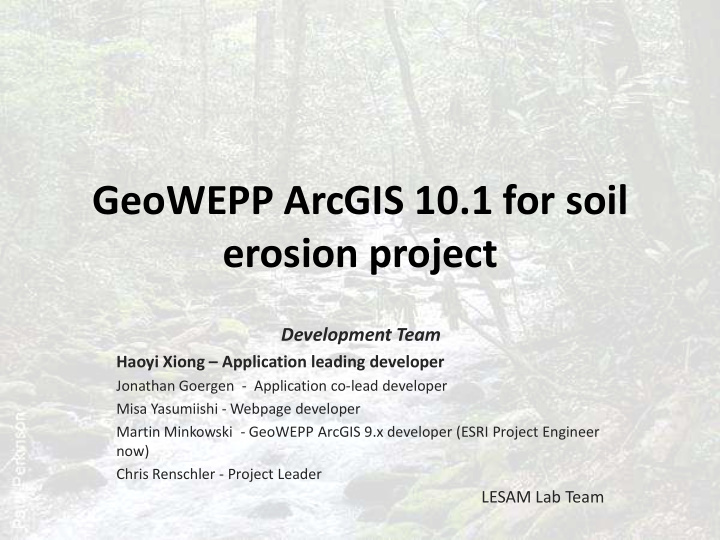



GeoWEPP ArcGIS 10.1 for soil erosion project Development Team Haoyi Xiong – Application leading developer Jonathan Goergen - Application co-lead developer Misa Yasumiishi - Webpage developer Martin Minkowski - GeoWEPP ArcGIS 9.x developer (ESRI Project Engineer now) Chris Renschler - Project Leader LESAM Lab Team
Software Development • Water Fall Model as developing scenario GeoWEPP ArcGIS 10.1 Software design Geo-spatial interface for WEPP (GeoWEPP) User Interface GIS Analysis Tool PRISM: TOPAZ: WEPP ArcGIS: climate GeoWEPP Launcher: channels & soil erosion map visualization data import subcatchments & runoff data & user interaction delineation prediction generator Land-use & UTM DEM Soil type Zone Inputs Inputs
Study Area 1. simulate the red part stream Goal: 2. reduce runoff for the farmland area East of Gowanda, NY Data source: USDA
Environmental modeling with GeoWEPP ( GeoWEPP extension - stream customization) ArcMap Hydrology Tools GeoWEPP without customization Stream GeoWEPP with Customization Subcatchments Delineation Delineation Erosion Prediction Generate climate data
Onsite assessment for best landuse management practice Target high erosion place Plant trees as buffer on these place Generate new erosion pattern
References • GeoWEPP: • Renschler, C.S. (2003) Designing geo-spatial interfaces to scale process models: The GeoWEPP approach. Hydrological Processes 17, p.1005-1017. • WEPP: • Laflen, J.M., L.J. Lane, and G.R. Foster. 1991. WEPP — a next generation of erosion prediction technology. Journal of Soil Water Conservation 46(1): 34 – 38. • Flanagan, D.C., and M.A. Nearing (eds.). 1995. USDA-Water Erosion Prediction Project (WEPP) Hillslope Profile and Watershed Model Documentation. NSERL Report No. 10, National Soil Erosion Research Laboratory, USDA-Agricultural Research Service, West Lafayette, Indiana. • GeoWEPP Applications: • Flanagan, D.C., J.R. Frankenberger, T.A. Cochrane, C.S., Renschler, and W.J. Elliot (2013) Geospatial Application of the Water Erosion Prediction Project (WEPP) Model. Transactions of the ASABE (in press) • Renschler, C.S., and D.C. Flanagan (2008) Site-Specific Decision-Making Based on GPS RTK Survey and Six Alternative Elevation Data Sources: Soil Erosion Prediction. Transactions of the ASABE 51(2):413-424. [2009 ASABE Superior Paper Award] • Renschler, C.S., and Lee, T. (2005) Spatially distributed Assessment of Short- and Long-term Impacts of Multiple Best Management Practices in Agricultural Watersheds. Journal of Soil and Water Conservation 60(6):446-456. • Renschler, C.S., Flanagan, D.C., Engel, B.A., Kramer, L.A., and Sudduth, K.A. (2002) Site-Specific Decision- Making Based on GPS RTK Survey and Six Alternative Elevation Data Sources: Watershed Topography and Delineation. Transactions of the ASAE 45(6):1883-1895. • Renschler, C.S., and J. Harbor (2002) Soil erosion assessment tools from point to regional scales – The role of geomorphologists in land management research and implementation. Geomorphology 47, p.189-209.
Recommend
More recommend